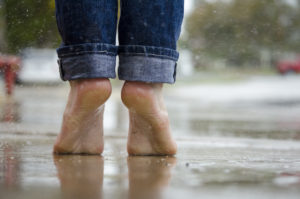
A lot of us have heard that it’s not uncommon to have a slight difference in the size of our feet or even legs. We often advise patients to buy shoes to the size of the larger foot so that toes don’t get cramped and cause pain. But when it comes to having a slight difference in the length of the legs, does it make any difference or have any effect on the body? Let’s start with the basics about limb length discrepancies.
What effect does a leg length difference have on a person?
For some, having a small difference in leg length won’t cause any problems, and they may not even be aware of the problem. For others, it can cause painful symptoms, alter their gait pattern (the way they walk), contribute to the development of other complications and negatively impact their quality of life. The extent of the effect largely depends on the measurable difference between the two legs and how the body is functioning (or not functioning) to compensate for the difference.
What causes a difference in leg length?
Differences may be caused by:
- Growth abnormalities
- Bone injury that results in healing in a shortened position (like a break or a fracture)
- Damage to the growth plate during childhood
- Bone disease and infection
- Neurological conditions
- Inflammatory conditions affecting the joints (like arthritis)
- Abnormal foot biomechanics
- Tightness and contractures of tissues
- Ligament laxity and weakness
You’ll notice that some of the above are talking only about muscles and tissues and not the bones – don’t worry, we haven’t made a mistake! This is because differences in leg lengths can have either a structural or a functional cause.
Structural differences describe a difference in the bone length of the thigh bone or the shin bone. This can result in a tilt of the hips and affect various joints and bones throughout the feet and legs, as well as the spine.
Functional differences describe an observed length difference when standing because of biomechanical issues involving the way the muscles, connective tissues and jones function together. These occur even if the bone length of the shin bone and thigh none are identical. This is often due to muscular contracture, particularly at the hips, as well as ligament laxity or tendon dysfunction that affects one foot more than the other.
What are the symptoms?
Symptoms can vary greatly depending on the extent of the difference and the resulting misalignment of the lower limbs. This position of the bones, joints, muscles and connective tissues will determine what structures are overloaded, stressed, stretched and limited in the way they move. Because of this, it is difficult to pinpoint precise symptoms, but may include:
- Altered gait pattern such as limping
- Shorter steps on the affected leg
- Slower walking speed
- Uneven loading and pressure distribution between the legs
- Stress fractures
- Muscular strain and tendinopathies
- Hip pain
- Knee pain
- Back pain
What should you do?
The first step is to get your leg length difference professionally assessed by your Podiatrist. We measure both structural and functional differences and ensure to get to the root of the problem and can address any factors playing a role in the difference to get the best results for you both now and into the future.
After determining the presence or absence of a difference and its extent, we’ll be able to formulate the best treatment plan for you, your age, your symptoms and the risk of future problems. This may include:
Orthotics to help correct any functional abnormalities and help bring the limbs into alignment with one another
Footwear modification, such as building up one shoe to bring the joints of the lower limbs into alignment
Stretching and strengthening tight or weakened muscles to help improve biomechanical function
If the case that the difference is severe and cannot be managed conservatively, surgical correction may be required – though this is much less common so don’t worry and just start with getting it checked out, so we all know what we’re dealing with.
Either way, our expert team at Perform Podiatry will be right alongside you every step of the way! We specialise in clinical biomechanics and restoring great foot function and health. For more information or to book in, give our team a call on
09 523 2333 or visit us at the One Health building in Remuera, just up from Broadway, Newmarket.
 A lot of us have heard that it’s not uncommon to have a slight difference in the size of our feet or even legs. We often advise patients to buy shoes to the size of the larger foot so that toes don’t get cramped and cause pain. But when it comes to having a slight difference in the length of the legs, does it make any difference or have any effect on the body? Let’s start with the basics about limb length discrepancies.
A lot of us have heard that it’s not uncommon to have a slight difference in the size of our feet or even legs. We often advise patients to buy shoes to the size of the larger foot so that toes don’t get cramped and cause pain. But when it comes to having a slight difference in the length of the legs, does it make any difference or have any effect on the body? Let’s start with the basics about limb length discrepancies.
